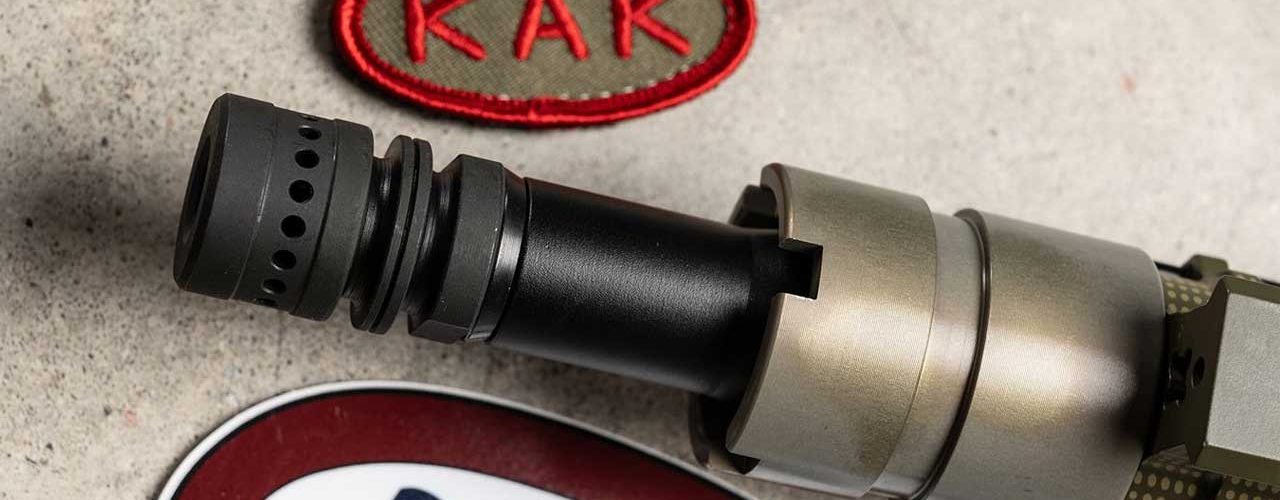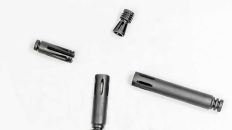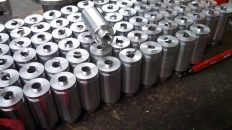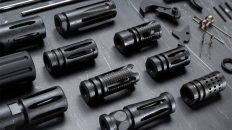The AR-15 is one of the most popular firearms in the market today, and for good reason. It’s versatile, customizable, and powerful. But if you’re a seasoned shooter, you know that there’s always room for improvement when it comes to accuracy and control. That’s where an AR-15 compensator comes into play.
In this comprehensive guide, we’ll dive into the purpose and benefits of an AR-15 compensator, and why it’s an essential accessory for any AR-15 owner. Compensators are just one type of muzzle device that can significantly enhance your shooting experience. To explore the full range of options, including brakes, flash hiders, and more, check out our guide on what are muzzle devices.
From reducing recoil and muzzle rise to improving follow-up shots and target acquisition, an AR-15 compensator can improve your shooting performance in numerous ways. We’ll explore the science behind compensators, discuss different types and designs, and provide insights on how to choose the right one for your specific needs.
So, if you’re ready to take your shooting skills to the next level, join us as we unravel the purpose and benefits of an AR-15 compensator in this comprehensive guide.
What is an AR-15 compensator?
An AR-15 compensator is a device that is attached to the muzzle of an AR-15 rifle. It is designed to help manage the recoil and muzzle rise of the firearm, making it easier for the shooter to maintain control and accuracy during rapid fire. Compensators work by redirecting the gases and pressure that are released when a round is fired, channeling them in a way that counteracts the natural tendency of the muzzle to rise and move upwards. This helps the shooter stay on target and make follow-up shots more quickly and precisely.
Compensators come in a variety of shapes, sizes, and designs, each with its own unique features and benefits. They are a popular accessory among AR-15 owners, particularly those who engage in competitive shooting or tactical training, where the ability to maintain control and accuracy is crucial. By understanding the purpose and function of an AR-15 compensator, shooters can make an informed decision about whether it is the right accessory to enhance their shooting performance.
It’s important to note that the use of a compensator may be subject to local laws and regulations, so it’s always a good idea to check with your local authorities before purchasing and installing one on your AR-15 rifle. Additionally, the installation and maintenance of a compensator should be done with caution and in accordance with the manufacturer’s instructions to ensure safe and effective use.
The purpose of an AR-15 compensator
The primary purpose of an AR-15 compensator is to help manage the recoil and muzzle rise of the firearm, which can be significant due to the high-powered cartridge used in the AR-15 platform. When a round is fired, the rapid expansion of gases and pressure inside the barrel creates a significant amount of force that pushes the muzzle upwards, causing the rifle to “jump” in the shooter’s hands. This can make it challenging to maintain a consistent sight picture and make accurate follow-up shots.
By redirecting and channeling these gases and pressure, a compensator can help counteract the natural tendency of the muzzle to rise, allowing the shooter to maintain better control and stability during rapid fire. This, in turn, can improve the shooter’s accuracy, speed, and overall shooting performance. Compensators can also help to reduce the perceived recoil, making the rifle feel more manageable and comfortable to shoot, particularly for smaller or less experienced shooters.
In addition to their practical benefits, compensators can also serve an aesthetic purpose, as they can enhance the overall appearance and customization of an AR-15 rifle. Many shooters choose to install compensators not only for their functional advantages but also to give their firearm a unique and personalized look. This can be especially important for competitive shooters or tactical enthusiasts who want to optimize their equipment for both performance and visual appeal.
How does an AR-15 compensator work?
An AR-15 compensator works by redirecting the gases and pressure that are released when a round is fired. When a bullet is discharged from the barrel of an AR-15, it creates a rapid expansion of gases and pressure that push the muzzle upwards, causing the rifle to “jump” in the shooter’s hands. This muzzle rise can make it challenging to maintain a consistent sight picture and make accurate follow-up shots.
A compensator is designed to counteract this muzzle rise by channeling and redirecting these gases and pressure in a specific way. The compensator is typically threaded onto the muzzle, which is part of the upper receivers on your AR-15, and it features a series of ports or vents that are angled in a specific direction. As the gases and pressure are released, they are forced through these ports, creating a counteracting force that pushes the muzzle back down towards the target.
The specific design and configuration of the compensator can have a significant impact on its effectiveness. Some compensators may feature a more aggressive or pronounced porting pattern, while others may have a more subtle or refined design. The angle and orientation of the ports can also play a role in how the compensator manages the recoil and muzzle rise, with some designs being more effective at reducing vertical movement, while others may be better at reducing lateral movement.
In addition to the physical design of the compensator, the materials and manufacturing process used can also affect its performance. High-quality compensators are often made from durable materials like stainless steel or titanium, and may feature precision machining or other advanced manufacturing techniques to optimize their effectiveness and durability.
Benefits of using an AR-15 compensator
Using an AR-15 compensator can provide a number of benefits for shooters, ranging from improved accuracy and control to enhanced comfort and reduced fatigue. Here are some of the key benefits of using an AR-15 compensator:
- Reduced muzzle rise: By redirecting the gases and pressure released when a round is fired, a compensator can significantly reduce the amount of muzzle rise experienced by the shooter. This helps to keep the rifle more stable and on target, making it easier to maintain a consistent sight picture and make accurate follow-up shots.
- Improved recoil management: Compensators can also help to reduce the perceived recoil of the AR-15, making the rifle feel more manageable and comfortable to shoot. This can be especially beneficial for smaller or less experienced shooters, who may struggle with the powerful recoil of the AR-15 platform.
- Enhanced accuracy: With better muzzle control and reduced recoil, shooters can achieve greater accuracy and consistency with their shots. This can be particularly advantageous in competitive shooting scenarios or tactical training, where precision and speed are critical.
- Faster target acquisition: The improved muzzle control provided by a compensator can also make it easier for shooters to quickly acquire and engage multiple targets in rapid succession. This can be a valuable asset in self-defense or tactical situations where split-second decision-making is required.
- Reduced shooter fatigue: Shooting an AR-15 without a compensator can be physically demanding, as the recoil and muzzle rise can quickly tire out the shooter. By reducing these forces, a compensator can help to alleviate shooter fatigue and allow for longer, more comfortable shooting sessions.
- Aesthetic enhancement: In addition to their practical benefits, compensators can also serve an aesthetic purpose, enhancing the overall appearance and customization of an AR-15 rifle. Many shooters choose to install compensators not only for their functional advantages but also to give their firearm a unique and personalized look.
By understanding the various benefits of using an AR-15 compensator, shooters can make an informed decision about whether this accessory is the right choice for their specific needs and shooting style.
Types of AR-15 compensators
There are several different types of AR-15 compensators available on the market, each with its own unique design and features. Here are some of the most common types of AR-15 compensators:
- Muzzle brakes: Muzzle brakes are a type of compensator that is designed to redirect the gases and pressure released when a round is fired in a way that helps to reduce recoil and muzzle rise. These compensators often feature a series of angled ports or vents that channel the gases in a specific direction, creating a counteracting force that pushes the muzzle back down towards the target.
- Linear compensators: Linear compensators are a type of compensator that is designed to redirect the gases and pressure in a more linear or straight-line fashion, rather than in a radial or angled pattern. These compensators are often used in situations where minimizing the amount of side-to-side muzzle movement is a priority, such as in close-quarters or urban environments.
- Hybrid compensators: Hybrid compensators are a combination of a muzzle brake and a linear compensator, incorporating elements of both designs to provide a balance of recoil and muzzle control. These compensators can be particularly effective for shooters who want to optimize their performance in a variety of shooting scenarios.
- Tunable compensators: Tunable compensators are a type of compensator that allows the shooter to adjust the amount of gas and pressure redirection, enabling them to fine-tune the performance of the compensator to their specific shooting style and preferences. These compensators often feature adjustable ports or other mechanisms that allow for customization.
- Suppressor-compatible compensators: Some AR-15 compensators are designed to be used in conjunction with a suppressor, featuring a specific configuration or design that allows them to work effectively with a suppressor attached. These compensators can be particularly useful for shooters who want to combine the benefits of a compensator with the sound-suppressing capabilities of a suppressor.
When choosing an AR-15 compensator, it’s important to consider the specific features and benefits of each type, as well as how they might fit with your shooting needs and preferences. Consulting with experienced shooters or firearms experts can also be helpful in determining the best compensator for your AR-15 rifle.
Choosing the right AR-15 compensator for your needs
When it comes to selecting an AR-15 compensator, there are several factors to consider to ensure you choose the right one for your specific needs and shooting style. Here are some key considerations:
- Intended use: Consider the primary purpose for which you’ll be using your AR-15, such as competition shooting, tactical training, or recreational use. Different compensator designs may be better suited for different applications, so it’s important to choose one that aligns with your intended use.
- Recoil management: If recoil reduction is a priority, look for compensators that are specifically designed to mitigate muzzle rise and felt recoil. Muzzle brakes and hybrid compensators are often good choices for this purpose.
- Muzzle control: If maintaining consistent muzzle control is more important, such as in close-quarters or urban environments, a linear compensator may be the better option, as it can help to minimize side-to-side movement.
- Customization: Some shooters prefer the ability to fine-tune the performance of their compensator, in which case a tunable or adjustable model may be the way to go. This can allow you to optimize the compensator’s performance for your specific shooting needs and preferences.
- Compatibility: Make sure the compensator you choose is compatible with your AR-15 parts, including the barrel diameter and thread pattern. Incompatible compensators can be difficult or even unsafe to install and use.
- Durability: Consider the materials and construction quality of the compensator, as this can impact its long-term performance and reliability. High-quality compensators made from durable materials like stainless steel or titanium are often a good investment.
- Aesthetic: While functionality should be the primary consideration, the visual appeal of the compensator can also be an important factor for some shooters, particularly those who want to customize the look of their AR-15.
By taking the time to carefully evaluate these factors and do your research, you can ensure that you select the AR-15 compensator that best suits your needs and shooting style. Consulting with experienced shooters or firearms experts can also be helpful in making an informed decision.
Installing an AR-15 compensator
Installing an AR-15 compensator is a relatively straightforward process, but it’s important to do so carefully and in accordance with the manufacturer’s instructions to ensure safe and effective use. The compensator is typically threaded onto the muzzle, which is part of the upper receiver of your AR-15. To understand more about how the upper receiver interacts with other AR-15 components, including the compensator, check out our detailed guide on what is an upper receiver.
- Ensure the firearm is unloaded and the magazine is removed. Always follow proper firearm safety protocols when handling any firearm.
- Carefully inspect the muzzle of your AR-15 to ensure it is free of any debris or obstructions. Clean the muzzle if necessary to ensure a secure and reliable connection.
- Align the compensator with the muzzle of the AR-15, making sure that the threads on the compensator match the thread pattern on the barrel. Some compensators may require the use of a specialized tool or wrench to properly align and thread the device.
- Carefully thread the compensator onto the barrel, taking care not to cross-thread or overtighten the connection. Follow the manufacturer’s recommended torque specification to ensure a secure and reliable fit.
- Once the compensator is installed, check the alignment and ensure that it is securely in place. You may need to use a torque wrench or other tools to confirm the proper installation.
- If your AR-15 is equipped with iron sights, you may need to adjust the sight picture to account for any changes in the muzzle profile or height caused by the installation of the compensator.
- Finally, test the compensator by firing a few rounds at a safe and approved shooting range. Monitor the performance and make any necessary adjustments to ensure optimal recoil and muzzle control.
It’s important to note that the specific installation process may vary depending on the make and model of your AR-15 and the compensator you choose. Always refer to the manufacturer’s instructions and consult with a qualified gunsmith or firearms expert if you have any questions or concerns about the installation process.
Maintenance and care for your AR-15 compensator
Proper maintenance and care are essential for ensuring the long-term performance and reliability of your AR-15 compensator. Here are some tips for maintaining your compensator:
- Regular cleaning: After each use, it’s important to clean your compensator thoroughly to remove any built-up carbon, powder residue, or other debris. This can be done using a solvent-based gun cleaning solution and a soft-bristle brush or cleaning rod.
- Lubrication: Applying a thin layer of high-quality gun lubricant to the threads and moving parts of the compensator can help to prevent corrosion and ensure smooth operation. Be sure to use a lubricant that is compatible with the materials used in your compensator.
- Inspection: Regularly inspect your compensator for any signs of wear, damage, or loosening. Look for cracks, dents, or other physical damage, and check that the compensator is securely tightened and properly aligned with the barrel.
- Storage: When not in use, store your compensator in a clean, dry, and secure location to protect it from the elements and prevent any potential damage. Consider using a protective case or storage container to keep the compensator safe and organized.
- Replacement: Over time, even the best-maintained compensators may need to be replaced due to normal wear and tear. Be on the lookout for any signs of significant deterioration or performance degradation, and consider replacing the compensator if necessary to ensure continued safe and effective use.
By following these maintenance and care guidelines, you can help to ensure that your AR-15 compensator continues to perform at its best for years to come. Remember to always consult the manufacturer’s recommendations and instructions for specific guidance on the care and maintenance of your particular compensator model.
AR-15 compensator myths debunked
As with any popular firearm accessory, there are a number of myths and misconceptions surrounding AR-15 compensators. Here are some of the most common myths and the facts that debunk them:
Myth 1: Compensators are only for advanced shooters.
Fact: Compensators can benefit shooters of all skill levels, from novice to expert. By helping to manage recoil and muzzle rise, compensators can actually make the AR-15 more accessible and easier to control for less experienced shooters.
Myth 2: Compensators are louder than a standard muzzle.
Fact: While compensators do redirect the gases and pressure released when a round is fired, this does not necessarily result in a louder report. Many high-quality compensators are designed to minimize noise and muzzle blast, often performing on par with or even quieter than a standard muzzle.
Myth 3: Compensators are illegal or restricted.
Fact: The legality of compensators varies by location, so it’s important to check your local laws and regulations before purchasing and installing one. In many areas, compensators are legal and widely used by both recreational and competitive shooters.
Myth 4: Compensators are only useful for competition shooting.
Fact: While compensators can provide a significant advantage in competitive shooting, they can also be beneficial for a wide range of shooting applications, including self-defense, tactical training, and recreational use. The improved recoil and muzzle control can enhance performance in any shooting scenario.
Myth 5: Compensators are difficult to install and maintain.
Fact: While the installation of a compensator requires some care and attention to detail, it is generally a straightforward process that can be easily accomplished by most AR-15 owners. Proper maintenance, such as regular cleaning and lubrication, is also relatively simple and can help ensure the long-term performance and reliability of the compensator.
By understanding and debunking these common myths, AR-15 owners can make more informed decisions about whether a compensator is the right accessory to enhance their shooting performance and experience.
Conclusion
In conclusion, an AR-15 compensator is a valuable accessory that can significantly improve the shooting performance and experience of AR-15 owners. By redirecting the gases and pressure released when a round is fired, a compensator can help to reduce recoil, minimize muzzle rise, and enhance the shooter’s overall control and accuracy.
Whether you’re a competitive shooter, a tactical enthusiast, or someone who simply enjoys spending time at the range, investing in a quality compensator can make a noticeable difference in your shooting capabilities. It allows for faster follow-up shots, greater precision, and a more enjoyable shooting experience overall. As with any firearm accessory, it’s important to choose a compensator that best fits your specific needs and preferences, and to ensure proper installation and maintenance to maximize its effectiveness.
By understanding the benefits and functions of an AR-15 compensator, you can make an informed decision that enhances your rifle’s performance and helps you achieve your shooting goals.





Add comment